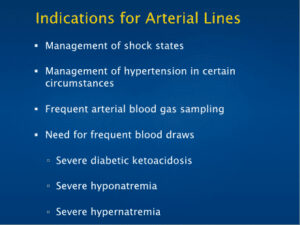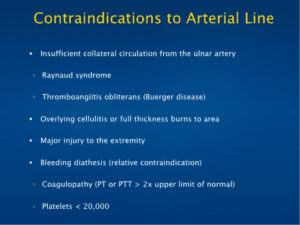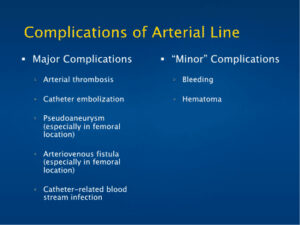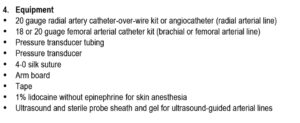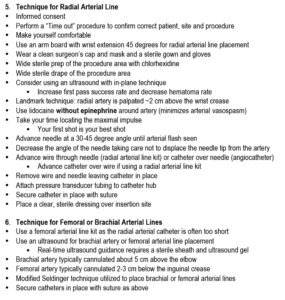Indications for arterial catheter placement
ARTERIAL LINE - cont'd info
Indications for Arterial Lines
- Management of shock states
- Management of hypertension in certain
circumstances - Frequent arterial blood gas sampling
- Need for frequent blood draws
-
- Severe diabetic ketoacidosis
- Severe hyponatremia
- Severe hypernatremia
Contraindications for arterial catheter placement
Contraindications to Arterial Line
- Insufficient collateral circulation from the ulnar artery
- Raynaud syndrome
- Thromboangiltis obliterans (Buerger disease)
- Overlying cellulitis or full thickness burns to area
- Major injury to the extremity
- Bleeding diathesis (relative contraindication)
- Coagulopathy (PT or PTT > 2x upper limit of normal)
- Platelets < 20.000
Complications of arterial catheter placement
Complications of Arterial Line
Major Complications
- Arterial thrombosis
- Catheter embolization
- Pseudoaneurysm
(especially in femoral
location) - Arteriovenous fistula
(especially in femoral
location) - Catheter-related blood stream infection
“Minor Complications”
- Bleeding
- Hematoma
Equipment for arterial catheter placement
Equipment
- 20 gauge radial artery catheter-over-wire kit or angiocatheter (radial arterial line)
- 18 or 20 guage femoral arterial catheter kit (brachial or femoral arterial line)
- Pressure transducer tubing
- Pressure transducer
- 4-0 silk suture
- Arm board
- Tape
- 1% lidocaine without epinephrine for skin anesthesia
- Ultrasound and sterile probe sheath and gel for ultrasound-guided arterial lines
Proper positioning and technique for arterial catheter placement
Technique for Radial Arterial Line
- Informed consent
- Perform a “Time out” procedure to confirm correct patient, site and procedure
- Make yourself comfortable
- Use an arm board with wrist extension 45 degrees for radial arterial line placement
- Wear a clean surgeon’s cap and mask and a sterile gown and gloves
- Wide sterile prep of the procedure area with chlorhexidine
- Wide sterile drape of the procedure area
- Consider using an ultrasound with in-plane technique
– Increase first pass success rate and decrease hematoma rate - Landmark technique: radial artery is palpated ~2 cm above the wrist crease
- Use lidocaine without epinephrine around artery (minimizes arterial vasospasm)
- Take your time locating the maximal impulse
- Your first shot is your best shot
- Advance needle at a 30-45 degree angle until arterial flash seen
- Decrease the angle of the needle taking care not to displace the needle tip from the artery
- Advance wire through needle (radial arterial line kit) or catheter over needle (angiocatheter)
- Advance catheter over wire if using a radial arterial line kit
- Remove wire and needle leaving catheter in place
- Attach pressure transducer tubing to catheter hub
- Secure catheter in place with suture
- Place a clear, sterile dressing over insertion site
Technique for Femoral or Brachial Arterial Lines
- Use a femoral arterial line kit as the radial arterial catheter is often too short
- Use an ultrasound for brachial artery or femoral arterial line placement
- Real-time ultrasound guidance requires a sterile sheath and ultrasound gel
- Brachial artery typically cannulated about 5 cm above the elbow
- Femoral artery typically cannulated 2-3 cm below the inguinal crease
- Modified Seldinger technique utilized to place brachial or femoral arterial lines
- Secure catheters in place with suture as above
Arterial catheter troubleshooting
- Over-damped waveform (Flattened waveform):
– Check set up for air in tubing (flush line), kinks in tubing or catheter
– Check to assure pressure bag is fully inflated
– Check to assure no WHITE caps left in the set up
– Check to assure all of the connections in the system are screwed on tightly
– Check to assure the set-up is levelled correctly
– Check to assure the scale is correct on the monitor - Under-damped (“fling” in waveform):
– Check set-up for air and flush all air out of tubing
– Remove extra tubing or extra stopcocks - No waveform
– Assure that tubing is connected to the patient
– Assure that proper cables are connected to monitor screen
– Assure that system is able to flush and zero properly
– Assure that the blood can be withdrawn from catheter
Coding for arterial catheter placement
Coding for Arterial Line Placement
36620 Percutaneous arterial line placement
76937 Vascular ultrasound

